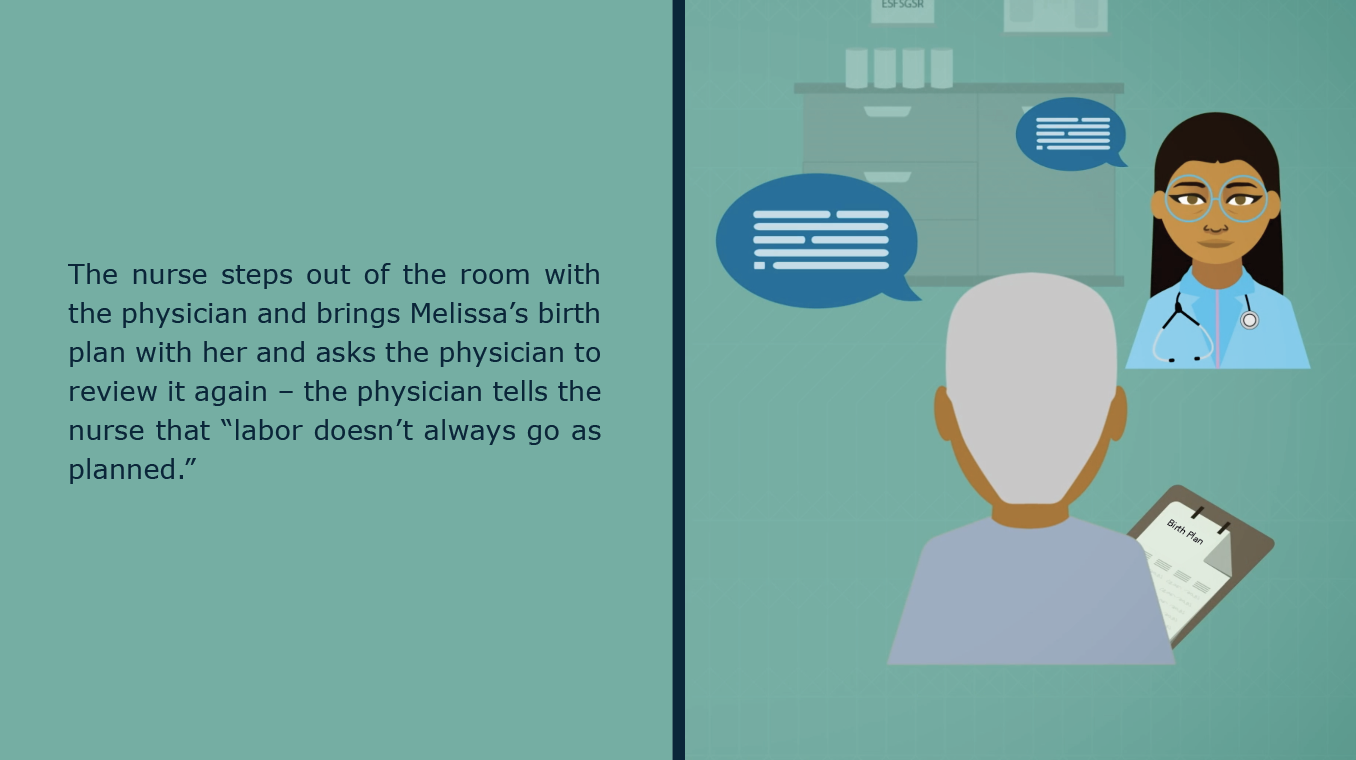Structures – Birthing Case
Melissa is a 24yo cis-gender Black woman (she/her) who is 38 weeks pregnant in her first pregnancy and presenting to the hospital in labor. She has been receiving prenatal care from a midwife in a community clinic and has had close support from an experienced doula named Chanel (she/her) in her local community. She doesn’t have any medical or surgical history, and has had routine prenatal care. During her prenatal care, she developed a plan for her birthing and postpartum care desires along with Chanel and her midwife where she desires an unmedicated vaginal birth, limited labor interventions, and immediate post-birth bonding with her newborn including exclusive breastfeeding.
Initially Melissa planned for birth at her home after seeing her family members have negative experiences with their births in hospitals, but her midwife recommended a hospital delivery because of Melissa’s body size (her BMI is 41) and concern for complications in labor and with birth.
She has been supported in this pregnancy by her partner, Stephanie (she/her) and Chanel. She lives in a single-family apartment that she has been renting for several years with Stephanie and her mother, and is currently employed as a teller at a bank.
What are your initial thoughts and feelings about Melissa's plan?
Upon admission to the hospital, Melissa is 3cm dilated. Melissa, Chanel, the labor nurse, and the midwife on-call go through Melissa’s birth plan together. She labors in the tub for several hours, with Chanel and Stephanie there for support, and has intermittent fetal monitoring as well as vital sign monitoring.
About 8 hours into her labor, her nurse notes that her blood pressure has been elevated and notifies the midwife on-call, who is not the same midwife that Melissa met when she was admitted.
After consulting with the on-call physician, the midwife informs Melissa that her blood pressure is too elevated to labor in the tub and that she needs to have continuous fetal monitoring. Chanel asks the midwife if there is any way Melissa might be able to stay in the tub a little longer because it’s providing her with a lot of relief, but the midwife says no because it’s hospital protocol that anyone with possible complications during labor cannot labor in the tub.
The midwife examines Melissa’s cervix and finds that she is now 4cm dilated. She tells Melissa that the on-call physician recommends starting oxytocin for labor augmentation to help expedite delivery given her newly elevated blood pressures. Melissa asks for some time to talk about this with her support people before starting the medication.
About 20 minutes later, the on-call physician comes into Melissa’s room to again recommend oxytocin and tells Melissa that if delivery isn’t expedited that she or the baby may experience consequences from her high blood pressure. The physician also tells Melissa that in addition to starting oxytocin that they would like to artificially rupture her membranes as well.
Chanel asks the physician if this is really necessary for her labor and that Melissa is hoping for a limited intervention labor and birth. The bedside nurse hands the physician Melissa’s birth plan, who sets it down and tells Melissa they are concerned for her and the baby’s safety. Melissa agrees to oxytocin and to have her bag of water opened.
Twelve hours after having oxytocin started, Melissa is in a lot of pain and the physician notes that there are fetal heart decelerations on the monitor. The physician recommends to Melissa that she consider an epidural for pain control and to have anesthesia on board just in case she needs to have an emergency cesarean section. Melissa and Chanel state that she really wants an unmedicated birth and really wants to avoid a cesarean section, and the physician says “just in case” they will have the anesthesiologist come talk to the patient so they can answer her questions.
Four hours later, Melissa has an epidural placed and the fetal heart tracing begins to show more decelerations. The physician comes into Melissa’s room and says that the baby isn’t tolerating labor very well and that she needs to have an emergency cesarean section since she is now only 5cm dilated. Her doula asks if they can try other methods to help before proceeding with a cesarean section, but the physician says no and consents the patient for a cesarean section.
Before leaving the room, the physician also asks the nurse to make sure Melissa is on a special mat to help with transferring Melissa from her bed to the OR table “because of her size so that the team can protect their backs.” Chanel asks the nurse if both she and Stephanie can be back in the operating room with Melissa, and the nurse states that because of hospital policy only one of them can be there with her.
Melissa is taken back to the operating room, and her epidural is no longer working for her pain and isn’t good enough for the surgery. The anesthesiologist recommends that she go under general anesthesia since there isn’t enough time to replace the epidural. Stephanie is then taken out of the operating room since Melissa is now undergoing general anesthesia per hospital policy, and Melissa is put under general anesthesia and undergoes an urgent cesarean section. Her surgery is complicated by a postpartum hemorrhage, and she receives 2 units of blood.
Eight hours after the delivery, Melissa sees her newborn for the first time. Melissa tells her nurse that she is having a lot of pain that is making it challenging to bond with her baby and is wondering if she can get more relief. The nurse reassures her that this is normal after surgery and her pain will get better with the medications she has been prescribed.
While the postpartum nurse is doing her routine screening and checks, she asks Melissa if she would like the doctors to refer her to a nutritionist or any resources for weight loss for her to be as healthy as possible for her new baby – Melissa declines this referral. Melissa says to the nurse however that she is feeling like she is having challenges with breastfeeding especially because of her continued pain, and asks for more lactation support.
The lactation specialist evaluates Melissa, and then leaves the room and tells the nurse that Melissa “doesn’t say much”, doesn’t seem very interested in breastfeeding, wasn’t following her suggestions, and is worried she won’t be able to be successful at breastfeeding. The nurse then recommends to Melissa that she should start supplementing with formula since she isn’t giving the baby enough milk.
Melissa decides to stop breastfeeding all together since it doesn’t feel like it’s working. Melissa is discharged home 3 days after her delivery, and doesn’t return for her scheduled postpartum visit 2 weeks later.


